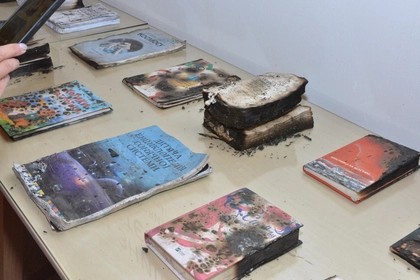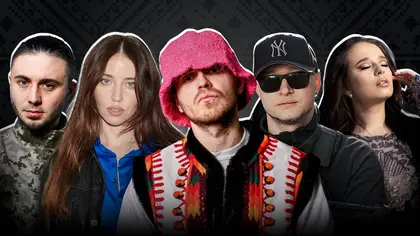Russia’s full-scale invasion of Ukraine is the first European war fully represented in pop music videos, according to local creatives, and the videos also reveal a culture that’s grappling with what is ‘authentically’ Ukrainian.
Last week, Kyiv Post did an evening’s worth of auditing of M1, Ukraine’s main music video channel on free-to-air television. Across music styles from love ballads to hip-hop to metal, more than 70 per cent of the broadcasted videos featured war-related images, lyrics or references, and/or featured patriotic Ukrainian themes. All the videos were in the Ukrainian language, often with English sub-titles.
JOIN US ON TELEGRAM
Follow our coverage of the war on the @Kyivpost_official.
The Ukrainian war genre has grown in quantity and quality since February 2022, as the security situation has improved, as resources and studios have become more available, and as artists have converted their experiences, sometimes direct and personal, into creative results.
Kyiv Post asked its younger staff members to nominate a selection of music videos from the war genre. See their selection in the text box which includes Kalush Orchestra’s ‘Stefania’, the winner of EuroVision 2022 that featured strong Ukrainian references. (EuroVision 2023 will be held in Liverpool, UK ‘on behalf’ of Ukraine who would, as winners, normally host the contest, but cannot due to security concerns.)

Portrait of a Book Fair in War Time
In providing their list, our Kyiv Post team members immediately pointed out a strong distinction. They said that they and many of their peers watching pop videos consider some ‘authentic’ and some as ‘sharavarshchyna’.
“Some are good and some are shit,” Tanya Pylypenko, Kyiv Post’s social media manager, said.
Literally translated, ‘sharavarshchyna’ is a state of being where people wear Ukrainian folkloric, Kozak-era clothing. The concept comes from the baggy, flowing, and brightly colored pants that have come to be (inaccurately) associated with the 17th and 18th century Kozak movement.
More broadly understood, ‘sharavarshchyna’ is how, during war-time, some contemporary performers and content producers are seemingly cashing in on the current popularity and relevance of Ukrainian patriotic, historical and cultural themes, and language.
“Now, some artists wear ethnic clothes in their music videos, or use folkloric words in their lyrics. All this, in my opinion, is manipulation of patriotic themes,” Pylypenko, 25, said. “It devalues the entire cultural heritage.”
“There’s another type of performer who has largely lived and conducted their activities in Russia. Now that the situation has changed, they have turned into ‘Ukrainians by default.’ They film clips in embroidered dresses and sang in Ukrainian. It’s ‘fake-lore’ not folklore,” Pylypenko, who has formerly worked with Ukrainian artists, said.
In wartime Ukraine, which music videos are authentic
and which are ‘fake-lore’?
You be the judge.
‘Stefania’ Kalush Orchestra’s
“The Anthem is Heard” by Skofka
“Думи” Artem Pivovarov feat. DOROFEEVA
“Bakhmut Fortress” by Antytila
“Hey Hey Rise Up” -Pink Floyd (feat. Andriy Khlyvnyuk of Boombox)
“What Kind of Kozak Are You?” by Anna Trincher
In June 2022, Kyiv Post’s correspondent met Antytila, a Ukrainian super group, whose five members were all voluntarily serving as combat medics in the Kharkiv region. We met in the courtyard outside a destroyed hospital in the devasted suburb of Saltivka. Because it had already been destroyed, the former hospital was deemed the safest place to rendezvous.
Antytila turned up driving their med-evac van. Blood stains were visible on its floorboards.
We asked Taras Topolya, Antytila’s front man and lead singer, whether music was still a part of their lives during the war.
“Well, we recorded the ‘2 Step’ video with English artist Ed Sheeran to raise funds and awareness for Ukraine and its freedom fight. Those were specific goals,” Topolya said.
“But there’s really no room in our hearts or our heads right now for music. That’s sad, but it’s true.
“Maybe in the future, there will be room, but we are soldiers and medics now. I hope there will be a time when we can be musicians again,” Topolya said.
His band’s clip with the English superstar has now had 16 million global views on YouTube.
Following the liberation of territory around Kharkiv, Antytila, have recently returned to recording. In February 2023, they cut and released a hard-hitting song and video titled ‘Fortress Bakhmut’ about the brutal, long-lasting battle in eastern Ukraine. With a concert on April 19 in Wroclaw, Poland, the band is now touring in Europe, the US and Canada, partly to raise funds for the war effort through their own foundation.
Julian Knysh is an Australian filmmaker of Ukrainian descent who has been living and working in Kyiv since the early part of the full-scale invasion period. He looks at Ukrainian film, video and other cultural development with both informed and independent eyes.
“The music video scene and other artistic developments show a contemporary generation of Ukrainians telling their own story. So many of that generation have a direct personal connection to the war, sometimes tragic, and their artistic output reflects that,” Knysh said.
On the issue of what is ‘authentic’ or otherwise, Knysh offers that “it’s a question of track record. If an artist has a history of representing Ukrainian culture and tending to use the Ukrainian language, they merit credibility with like-minded Ukrainians.”
“If, however, some artists are now newly using Ukrainian cultural icons, the public is understandably cynical about being manipulated and manoeuvred for someone’s commercial gain or other self-interest,” he said.
Knysh, though, points out that two other aspects need to be considered: that the appropriation of Ukrainian culture isn’t an entirely bad phenomenon, and that ‘sharavarschyna’ has strong historical precedents.
“Even if it’s somewhat opportunistic, it’s still interesting that some artists are ‘converting’ to a Ukrainian aesthetic in this period. That too is an indicator of a culture that’s changing, especially its deRussification,” Knysh said.
“’Sharavarshchyna’ has colonial roots. For example, during the 1920s Ukrainization period of the USSR, authorities tried to ‘whitewash’ the Communist system and make it palatable to Ukrainians by using Ukrainian cultural icons,” Knysh said.
“It was then a case of manipulation and of the Soviet state deciding what cultural aspects are or are not officially acceptable. And, they tended to use the ‘safest’ stereotypical aspects and caricatures of Ukrainian culture – such as cliched or derived representations of village life and folkloric traditions – rather than aspects that were authentic, more modern and/or potentially more challenging to Soviet and Russian control,” Knysh said.
Looking forward, Knysh notes the challenge for Ukrainian music and for Ukrainian arts generally.
“Balancing respect for the war-time experience and all its turbulent and traumatic emotions with an outlook on the future and a culture that informs that future. That will be a very interesting dynamic,” Knysh said.
You can also highlight the text and press Ctrl + Enter







